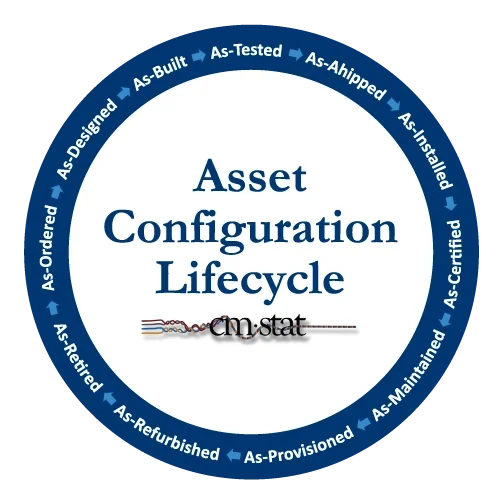Why not use PDM for all CM requirements? Part 2
(Part 2 of 3)
In our last CMsights post we began to unpack a question we hear frequently: why can’t we just use existing PDM software for all of our hardware configuration management software requirements, including those uses downstream of product engineering in the supply or aftermarket service chains?
Managing the configuration of a new product line as it is being designed, engineering, and manufactured is only one use-case, albeit an important one, of configuration management software solutions.
As illustrated in this figure, there are many other phases of the configuration lifecycle management past engineering which must be served equally well, especially for long-life assets in field use for many years if not decades at a time.
The long thick tail of configuration management after engineering.
Examples where managing the as-configured status consumes more effort than the original as-designed configuration includes big products and complete systems like ships, aircraft, mining equipment, or offshore platforms. But this is also true for smaller and equally critical site configurable components – both physical and digital – like those found in aviation MRO facilities, test and certification sites, refurbishment docks, avionics service depots, prototyping laboratories, and documentation repositories for warranty repair work.
For these applications of CM, while there can be many creators or authors of configuration-related data, there are far more users and consumers beyond the OEM’s engineering CAD desktop or manufacturing shop floor.
It has been CMstat’s experience over the years that these downstream CM users have quite different prerequisites, priorities, and pain thresholds for a CM solution. Rarely does an engineering-centric PDM software product or monolithic enterprise PLM system offer the role-based CM functionality, rapid deployment, instant usability, and immediate affordability which they seek.
To better understand how these down-stream requirements of CM may differ, we often suggest that our customers ask themselves the following questions about any CM solution they are considering, especially if it is based on their existing PDM software:
How well out-of-the-box without customization does it support the five tenets of CM: configuration planning, identification, change control, status accounting, and traceability audits?
Is inherent support of industry-specific CM standards, rules, and best practices built-in, or must they be manually added and configured?
Can different levels of configuration control be performed without requiring all of the OEM’s original CAD or BOM data that may not be available nor accurate years later for a service partner?
Is the CM functionality independent of where the CAD and PDM data may have originated?
Is it capable of supporting multi-CAD and multi-PDM operating environments typical of those found in aggregate across the extended supply and service chains?
Is having a complete product structure mandatory, even for component-level CM work performed by a supplier or service chain partner?
Can users restrict, filter, or throttle automatic updates to the product structure such that as-configured records of fielded products are not prematurely or unintentionally polluted?
How wide and deep is the support for definition and use of baselines and configuration items? As example, can mission-critical contractor materials or government provided items be managed, while retaining parent/child relationships, within any desired level of indenture?
Does it offer an As-Configured module which makes it possible to compare in real-time the as-designed as-installed and as-maintained records of fielded products by serialized assembly records, lot number, shipment record, software version levels, certification status, non-standard designator, or other user-defined attributes?
How easy can a where-used, effectivity search, or impact assessment be performed by the occasional non-expert user?
Can workflows be reconfigured on-the-fly by users, with appropriate roles, to support one-off review processes?
Does it offer a distributed document vault system for extended security?
Can restricted and secured access be provided for suppliers and service partners on a project-by-project basis?
Must users be engineers, who use the system frequently, to just pull configuration change history, generate custom reports, or perform online collaborative document reviews?
How much IT support and budget is required to deploy, maintain, and upgrade?
Can it be implemented rapidly for new products, projects, or sustainment partners, and is the overhead elastic enough to be resized or retired as usage demands change with maturing programs?
How overweight is the system in capability and complexity that routine users don’t need? As example, how applicable is the dashboard cockpit to the roles of a configuration specialist, occasional user, or program manager?
Sometimes the answer to these questions will support a decision to use an existing PDM solution. However, more often than not, it will lead to the conclusion that the original PDM requirements of product engineering are quite different than the CM needs of downstream users inside or outside the enterprise.
If your organization would like help in answering these questions – or just ranking their relevancy and importance to your specific business needs – then visit CMstat at the CMPIC CM Trends ’17 conference on August 28 – 30 in Orlando, Florida. More event information at https://www.cmpic.com/configuration-management-seminar.htm. Or if you can’t make it there, send a request to information@cmstat.com for an on-demand demonstration of how CMstat’s CM solution PDMPlus addresses each of these questions.
Next month in the final Part 3 of this series we will compare the pros and cons of three different strategies for providing CM capabilities across the enterprise and supply chain. These approaches are to: customize and extend engineering PDM, invest and embrace enterprise PLM, or relax and exploit best-of-class CM tools that can work with whatever CAD, PDM and PLM strategies your enterprise may have now or in the future that will likely change!
Receive CMsights
Subscribe to CMsights News for the latest updates from CMstat on Configuration Management, Data Management, EPOCH CM, and EPOCH DM.
Request a Demo
See how EPOCH CM and EPOCH DM support industry standards and best practices in Configuration Management and Data Management.


